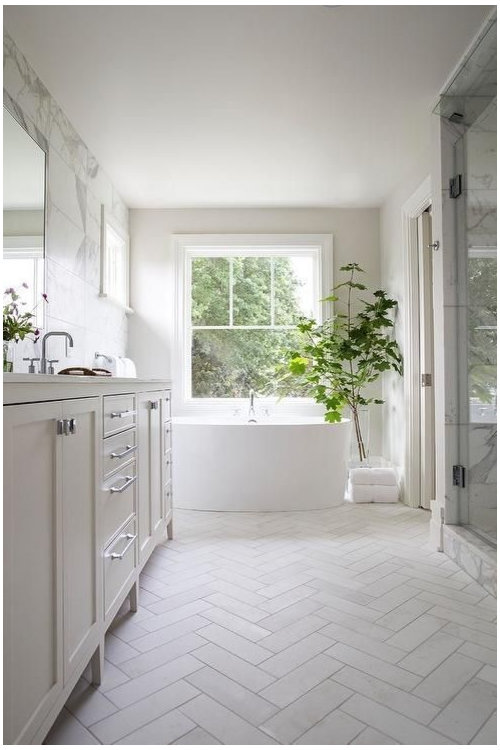Have you ever walked into a beautifully designed space and found yourself captivated by the elegant flow of a herringbone floor? This classic pattern, reminiscent of vintage Parisian apartments and charming country cottages, adds a touch of sophistication and timeless appeal to any room. But when embarking on your own herringbone tile project, a crucial decision looms large: What is the best tile size for this intricate design?

Image: www.houzz.com
Choosing the right tile size for a herringbone pattern is more than just aesthetics. It directly impacts the visual effect, the amount of material needed, and even the installation process. This article will dive into the world of herringbone tile sizes, exploring the factors that influence your choice and highlighting the most popular options for different applications.
Understanding the Herringbone Pattern
Before we delve into tile sizes, let’s understand the herringbone pattern itself. It’s essentially a geometric arrangement of rectangular tiles laid in a staggered V-shape, creating a visually dynamic and intricate design. The pattern’s inherent beauty lies in its ability to create a sense of movement, flow, and depth, adding character and dimension to any space.
Factors Influencing Tile Size Selection
Several factors come into play when determining the ideal tile size for your herringbone floor. Let’s analyze each factor to guide your decision:
1. Room Size and Layout
The dimensions of your space are paramount. Smaller rooms benefit from smaller tile sizes, as they tend to make the area appear larger. Conversely, large rooms can accommodate larger tiles, creating a grand and spacious feel. For instance, a herringbone floor in a compact bathroom may use 4″ x 8″ tiles, while a spacious living room could feature 12″ x 24″ tiles.

Image: www.pinterest.com
2. Tile Material and Thickness
Tile thickness influences the overall design and installation. Thicker tiles, typically found in porcelain and ceramic, lend a more substantial feel and are better suited for high-traffic areas. Thinner tiles, common in natural stone like marble and slate, create a more delicate and elegant look. The thickness can also affect the installation process and the amount of grout required.
3. Grout Line Width
The width of the grout lines between the tiles is a key stylistic element that affects the overall visual impact of the herringbone pattern. Smaller grout lines create a more seamless, continuous flow, while wider grout lines emphasize the intricate design and individual tiles. The tile size directly influences the grout line width. For example, smaller tiles like 2″ x 4″ can handle smaller grout lines, whereas larger tiles like 12″ x 24″ may require wider grout lines to maintain a balanced visual.
4. Design Style and Personal Preference
Ultimately, your design style and personal preference are the most important factors. Consider the overall aesthetic of your space, your desired level of detail, and your desired visual impact. A more minimalist or modern style may favor smaller tiles with subtle grout lines, while a traditional or rustic aesthetic might prefer larger tiles with wider grout lines.
Popular Tile Sizes for Herringbone Floors
Now that we’ve explored the factors influencing tile size selection, let’s delve into some popular tile sizes suitable for herringbone patterns:
1. Small Tiles: 2″ x 4″ or 3″ x 6″
These small tiles create a delicate and intricate herringbone pattern. They’re ideal for smaller spaces, bathrooms, kitchens, or any area looking for a classic, timeless appeal. The smaller size allows for narrower grout lines, lending a seamless and sophisticated look.
2. Medium Tiles: 4″ x 8″ or 6″ x 12″
Medium-sized tiles provide a balance between intricate detail and visual impact. They’re versatile enough for various spaces, from entryways and hallways to living rooms and bedrooms. The medium size allows for moderate grout lines, offering a balance between visual flow and defined pattern.
3. Large Tiles: 8″ x 16″ or 12″ x 24″
Large tiles create a dramatic and contemporary herringbone pattern. They’re suitable for expansive spaces, such as living rooms, dining areas, or foyers, where they add a sense of grandeur and openness. Due to their size, larger tiles typically require wider grout lines to maintain a balanced visual and manageable installation process.
Tips for Choosing the Best Tile Size
To make an informed decision, consider these tips:
1. Visualize the Pattern
Create a mock-up using different tile sizes in your chosen space. This visual aid can help you understand how the herringbone pattern will look with varying tile sizes and grouting. Consider using online tile visualization tools or creating a small-scale sample on your floor with masking tape to guide your choice.
2. Budget and Material Cost
Factor in the cost of the tiles and the amount of material needed. Larger tiles cover more area with fewer units, which may translate to lower costs. However, if you choose a high-end material like natural stone, even fewer tiles can lead to a significant overall expense.
3. Consider Installation Complexity
Smaller tiles require more cutting and precise placement, increasing the installation time and complexity. Larger tiles generally simplify the installation process, but require careful handling and specialized tools.
4. Seek Professional Advice
A skilled tile installer can offer valuable insight into the best tile size for your project, taking into account your specific space, desired aesthetic, and budget.
Best Size Tile For Herringbone Pattern Floor
Conclusion
Choosing the best tile size for your herringbone pattern floor hinges on a thoughtful consideration of your space, design style, budget, and desired outcome. Whether you opt for delicate small tiles, versatile medium tiles, or dramatic large tiles, remember that the herringbone pattern is a timeless design element that adds character and sophistication to any space. By understanding the factors that influence your choice and following these tips, you can create a stunning herringbone floor that will be the envy of all who enter your home.





